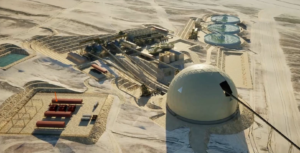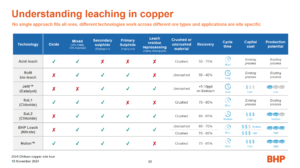In a large ranging presentation forming a part of its simply accomplished 2024 Chilean copper web site tour, BHP supplied a complete perception into the way it intends to proceed delivering copper progress at its operations, together with its flagship Escondida operation, through a collection of pathways.
Escondida like plenty of different lengthy life copper mines is going through grade decline and elevated ore hardness. Nevertheless it stays the world’s largest copper operation. It has been in manufacturing since 1990, with a remaining mine lifetime of 65+ years and a Useful resource of 26 billion tonnes at 0.53% copper. Ore is extracted from two open pits – Escondida and Escondida Norte.
Main investments within the mine have included a deal with water and vitality effectivity. Some US$4 billon has been invested in desalinated water provide for BHP’s mines in Chile over final 15 years, together with for Escondida; and Escondida’s concentrators have operated solely with desalinated water since January 2020. Plus BHP’s mines in Chile have been utilizing 100% renewable energy since January 2022 through Energy Buy Agreements. The Vitality and Recent Water Sustainability Program at Escondida additionally makes use of digital innovation to gather knowledge in actual time to handle and management water and vitality consumption. The reductions in consumption delivered are vital – 3.5 gigalitres of water since FY22 and 118 GWh of electrical energy since FY22.
The broad long run timeline for Escondida shifting into the 2030s will see an preliminary manufacturing decline because the ageing Los Colorados concentrator (96,000 t/d) is demolished, adopted by a manufacturing enhance as a brand new concentrator ramps up and high-grade ore from PL2 is accessed. BHP Leach utility on ripios can even start to contribute. Within the close to time period, BHP is seeking to prolong the lifetime of Los Colorados with timing optionality and in addition make expansions on the Laguna Seca concentrators (LS1 at the moment handles 130,000 t/d and LS2 147,000 t/d).
A significant focus is growing mining depth to assist the long run progress of concentrator capability. The present Escondida ex-pit mine motion is ~400 Mt/y. Some 170 Mt/y of this 400 Mt/y is ore, of which 134 Mt/y goes to the concentrators, with a mean grade 0.82% Cu ‒ whereas 36 Mt/y to sulphide leach, with a mean grade of 0.42% Cu. Key adjustments in mine design, a fleet improve and productiveness initiatives might allow enhance this to >500 Mt/y. There’s additionally potential for brand new open pit in Pinta Verde will exploit oxide leach latent capability.
Strikes might embrace bigger pushbacks, extra entry ramps, a change in pit wall angle plus extra and bigger vans (the brand new ultraclass fleet probably growing to round 190), and bigger shovels – the mine is already one of many first customers of Komatsu’s P&H 4800 XPC so extra shovels at this scale are more likely to be deployed.
Present mining gear and glued infrastructure at Escondida totals 188 vans plus 18 electrical shovels then about 65 ancillary gear items. There are 4 main crushers and a conveyance system for transport to concentrators plus one main crusher and a conveyance system for the leaching route ie cathodes. A full fleet substitute is underway to the beforehand introduced new Caterpillar diesel-electric 400 ton class 798 AC truck fleet which can assist unlock further capability and allow transition to autonomous operations. This was mentioned by IM Editorial Director Paul Moore with BHP’s Vice President Know-how, Minerals Americas, Pedro Hidalgo, on the EXPONOR present in Antofagasta earlier this yr, together with its autonomy progress at Spence, the place a complete of 33 Komatsu 980E vans have been efficiently automated by March 2024.
IM Editorial Director Paul Moore with Pedro Hidalgo, BHP VP Know-how, Minerals Americas, at EXPONOR 2024
All of the autonomous vans are at the moment working in an autonomous zone in Escondida Norte – to this point 15 out of a fleet of 36 Caterpillar 798 AC vans (see lead picture) with all 36 there anticipated to be operating autonomously by July 2025. The overall conversion of 141 vans is anticipated by FY30 (with 52 vans transformed and working at Escondida Norte by FY27). BHP says the primary achievements through the eight months of operation thus far embrace zero security occasions and over 17 Mt of waste motion. Autonomous drills (Epiroc Pit Vipers utilizing the OEM automation system) can be progressing aligned to plan (20% to this point) with zero security incidents throughout deployment.
On to the processing crops themselves. BHP has recognized 40,000 t/d latent capability within the Laguna Seca concentrators because of the influence of hardness on balls mills and flotation circuits. So one possibility for extra manufacturing is to organize Laguna Seca for the hardness enhance by utilising new applied sciences to extend restoration. The plan is to deploy a brand new third line with one other SAG mill to ship the extra 40,000 t/d (~15 Mt/y above the present 100 Mt/y) of throughput ‒ however combining this with massive mechanical cells and an Eriez Hydrofloat coarse particle flotation (CPF) plant to enhance restoration by ~1-4 ppt from 85% in FY24. This transfer at Laguna Seca represents capital environment friendly growth and requires minimal incremental ongoing working prices. A remaining funding choice (FID) will probably be made CY27/28.
This newest capability can even align with plans for Los Colorados. There’s the choice to increase the lifetime of the Los Colorados plant past FY27 to FY29 (FID CY25/26) with an optionality to FY31. This could ship an incremental 130-145,000 t/y copper manufacturing with out the necessity for a brand new environmental allow. As soon as it’s demolished, it is going to allow entry to key mine pushbacks as it’s underlain by excessive grade ore. This plant will probably be changed by an all new concentrator (FID CY27/28) with a 125,000 t/d (45 Mt/y) capability. This can embrace a conventional comminution circuit with SAG mill, pebble crushing and ball milling (SABC) for extra flexibility ‒ however as at Laguna Seca will use revolutionary industry-proven applied sciences in flotation – massive mechanical cells and Eriez Hydrofloat coarse particle flotation (CPF).
How the brand new concentrator to interchange Los Colorados may look

Lastly to leaching – which has the benefit of no tailings plus decrease water and vitality consumption. It produces cathode (so no smelting) and may function in parallel with the concentrator. It’s also one other solution to economically deal with low grade ores and coarse materials. BHP is assessing a number of alternatives for Escondida, together with a brand new oxide leach pad, leach residue reprocessing (ripios), a sulphide leach run-of-mine pad together with different new sulphide pads. BHP is actively trialling a variety of applied sciences, throughout each BHP and third-parties in addition to partnership applied sciences.
It already has 20+ years of growth and supply of latest leaching applied sciences and has a aggressive benefit in having the BHP Innovation Leaching Facility at Escondida, which covers the total innovation chain. Right here there’s a demonstrated monitor file with bio-leach, chloride leach and nitrate leach applied sciences. It has pilot scale testing with scale-up throughout a spread of column sizes (1 m to 10 m excessive). Variability testing and course of enchancment work is at the moment underway.
BHP is taking a look at quite a lot of present and new leaching applied sciences for Escondida

Present Escondida cathode manufacturing is about 200,000 t/y with a latent capability of about 100 t/y anticipated to develop as oxide ore depletes. There’s the chance to leverage water and renewable energy provide to web site plus the size and breadth presents a number of areas for deployment of present and new leaching applied sciences. There’s additionally the potential to reinforce synergies between concentrator and leaching.
Trying on the choices – chloride leaching (Full SaL) improves restoration and allows new crushed materials (blended ore and secondary sulphide) to be processed on the oxide leach pad. Jetti Catalyst can enhance restoration on the present sulphide leach pad by ~5-10 ppt. Then BHP’s personal BHP Leach patented nitrate leaching has the potential to get well further copper from ~20 years of leach residues (ripios) plus course of sulphide ROM at greater recoveries and shorter cycle instances than the present bioleach course of. BHP additionally has optionality by way of Nuton leaching know-how.
In additional element, the Escondida BHP Leach ripios utility (FID CY27/28) will flip in any other case leached ore again into usable materials. It affords shorter leaching cycle instances (-55% vs. standard leaching) for processing in addition to restoration advantages (~50% further restoration on the remaining copper that may now be leached). BHP says the ripios utility is a quick possibility for large-scale implementation and reveals potential for a better IRR versus processing ore ‒ an illustration plant is beneath development and can show the know-how on run-of-mine materials at scale. Preliminary outcomes are deliberate late CY25 that may deliver knowledge on copper restoration, reagent consumption and fuel administration. Cycle instances will probably be ~250-350 days, with recoveries of ~60-70%.





